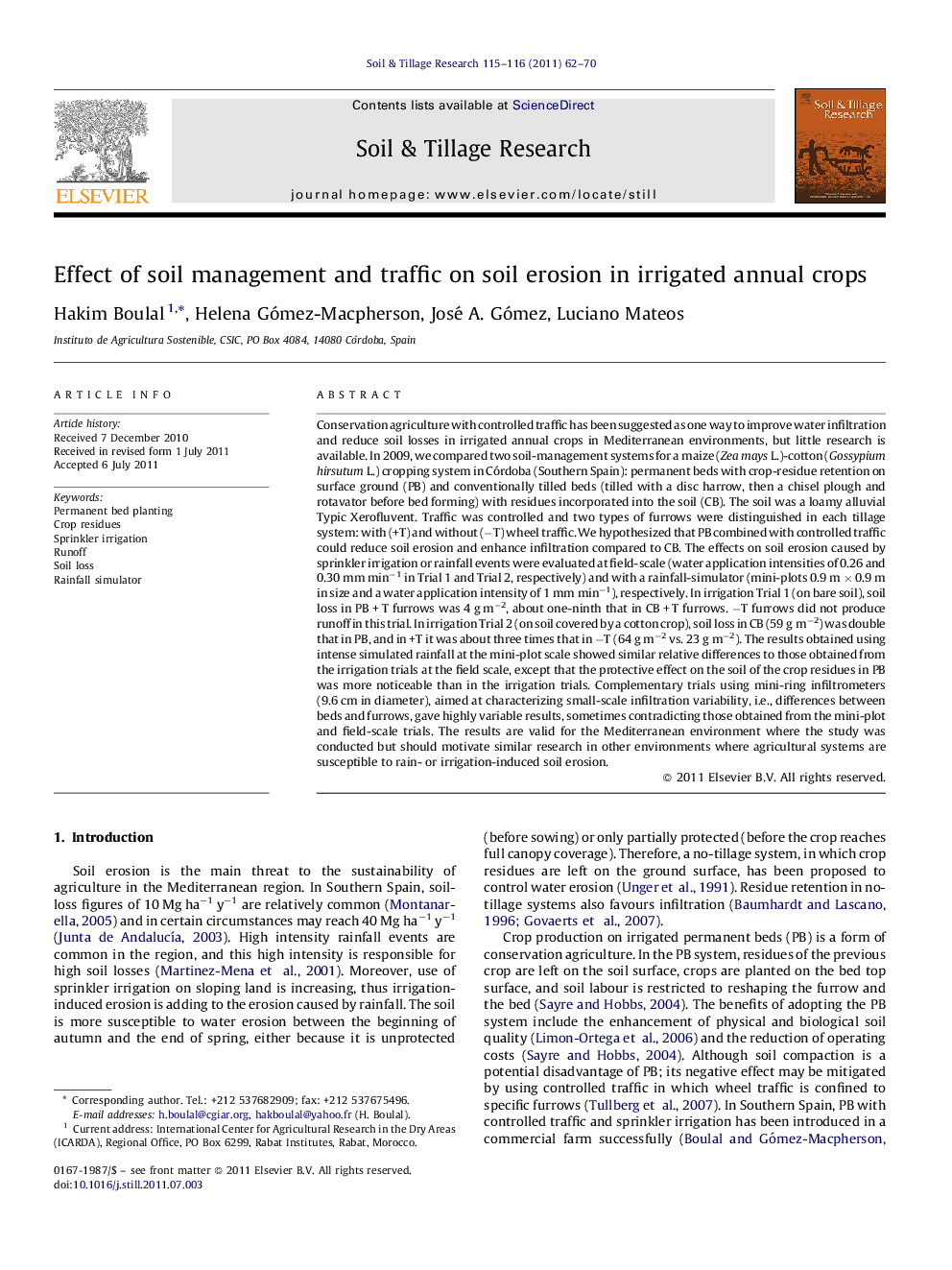| کد مقاله | کد نشریه | سال انتشار | مقاله انگلیسی | نسخه تمام متن |
|---|---|---|---|---|
| 306122 | 513074 | 2011 | 9 صفحه PDF | دانلود رایگان |

Conservation agriculture with controlled traffic has been suggested as one way to improve water infiltration and reduce soil losses in irrigated annual crops in Mediterranean environments, but little research is available. In 2009, we compared two soil-management systems for a maize (Zea mays L.)-cotton (Gossypium hirsutum L.) cropping system in Córdoba (Southern Spain): permanent beds with crop-residue retention on surface ground (PB) and conventionally tilled beds (tilled with a disc harrow, then a chisel plough and rotavator before bed forming) with residues incorporated into the soil (CB). The soil was a loamy alluvial Typic Xerofluvent. Traffic was controlled and two types of furrows were distinguished in each tillage system: with (+T) and without (−T) wheel traffic. We hypothesized that PB combined with controlled traffic could reduce soil erosion and enhance infiltration compared to CB. The effects on soil erosion caused by sprinkler irrigation or rainfall events were evaluated at field-scale (water application intensities of 0.26 and 0.30 mm min−1 in Trial 1 and Trial 2, respectively) and with a rainfall-simulator (mini-plots 0.9 m × 0.9 m in size and a water application intensity of 1 mm min−1), respectively. In irrigation Trial 1 (on bare soil), soil loss in PB + T furrows was 4 g m−2, about one-ninth that in CB + T furrows. −T furrows did not produce runoff in this trial. In irrigation Trial 2 (on soil covered by a cotton crop), soil loss in CB (59 g m−2) was double that in PB, and in +T it was about three times that in −T (64 g m−2 vs. 23 g m−2). The results obtained using intense simulated rainfall at the mini-plot scale showed similar relative differences to those obtained from the irrigation trials at the field scale, except that the protective effect on the soil of the crop residues in PB was more noticeable than in the irrigation trials. Complementary trials using mini-ring infiltrometers (9.6 cm in diameter), aimed at characterizing small-scale infiltration variability, i.e., differences between beds and furrows, gave highly variable results, sometimes contradicting those obtained from the mini-plot and field-scale trials. The results are valid for the Mediterranean environment where the study was conducted but should motivate similar research in other environments where agricultural systems are susceptible to rain- or irrigation-induced soil erosion.
► We evaluated sprinkler irrigation-induced and simulated rainfall-induced soil erosion in a maize-cotton cropping system.
► Two soil managements were compared: permanent (PB) and conventional (CB) bed systems, both with controlled traffic.
► Compared to CB, PB increased infiltration and reduced runoff and soil loss.
► Wheel traffic reduced infiltration and increased runoff and soil loss.
Journal: Soil and Tillage Research - Volumes 115–116, October–November 2011, Pages 62–70